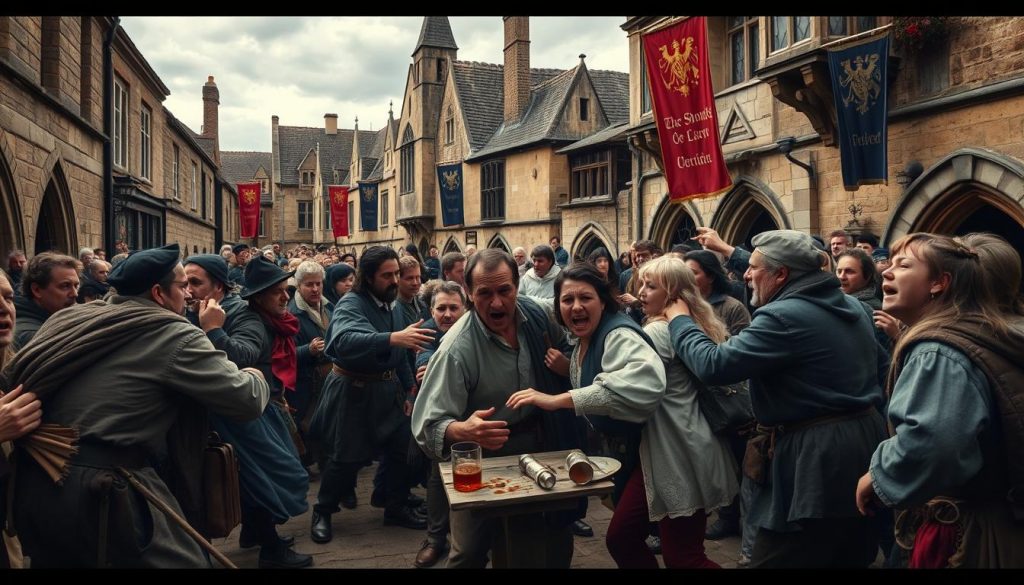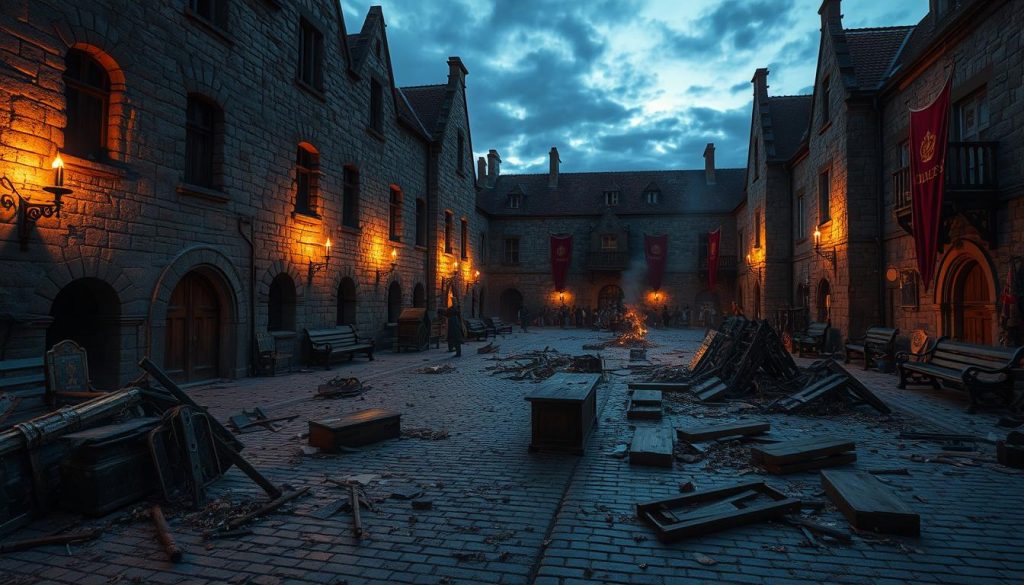The St. Scholastica Day Riot (1355): A Medieval University Conflict
The St. Scholastica Day Riot happened on February 10, 1355. It’s a key moment in Oxford’s medieval history. It shows the deep-seated tensions between the University of Oxford and local residents.
Anúncios
This conflict highlights the ongoing battles between scholars and townsfolk. They had a long history of clashes. This riot led to a lot of deaths and damage.
Exploring this riot, we see a society facing violence and economic changes. The Black Death had reshaped the economy. People were both studying and involved in local politics. This article will look at the key players, the chaos, and the lasting effects of this event in Oxford.
Introduction to the St. Scholastica Day Riot
The St. Scholastica Day riot happened on February 10, 1355. It was a key moment in the history of the University of Oxford and its town. This event shows the deep-seated tensions between academics and townspeople during the medieval times.
The University of Oxford grew in power after it was founded in 1096. A royal charter in 1248 gave it a lot of power over education and disputes. Before the riot, there were other violent incidents, like the lynching of two students in 1209.
Anúncios
The St. Scholastica Day riot was a clash of interests between scholars and locals. It shows how cultural and historical events shape Oxford’s identity. The riot changed the city, leading to new laws and a different relationship between the university and the town.
Historical Background of Medieval Oxford
Oxford’s history goes back to at least AD 912. This rich legacy is deeply connected to England’s history. The city became a center of learning, with events shaping its town history and university history.
By 1002, the St. Brice’s Day massacre had a devastating impact. Many Danes lost their lives. In 2008, archaeologists found remains of over 30 victims, showing Oxford’s violent past.
In the 12th century, Oxford’s Jewish community grew. By 1191, the city charter was granted, boosting growth. The university started around 1096, with the teaching of magistri. It grew fast after 1167, when Paris banned teaching.
By 1120, scholars were gathering in Oxford. This marked the beginning of formal academic institutions.
In the mid-13th century, colleges like University College (1249), Balliol (1263), and Merton (1264) were founded. These developments enriched academic life but also caused conflicts. The St Scholastica Day Riot in 1355 showed a community facing economic changes and unrest.
This history shows how medieval Oxford’s conflicts were shaped by academic and local issues. It highlights the complex relationship between the town and gown. This early period set the stage for the ongoing story of medieval Oxford.
| Year | Event |
|---|---|
| 912 | Earliest mention of Oxford in the Anglo-Saxon Chronicle. |
| 1002 | St. Brice’s Day massacre occurred, resulting in many deaths. |
| 1142 | Siege of Oxford during The Anarchy. |
| 1191 | City charter granted to Oxford. |
| 1249-1264 | Establishment of the first colleges: University College, Balliol, and Merton. |
| 1355 | St Scholastica Day Riot resulted in significant loss of life. |
Key Players in the Riot
The St. Scholastica Day Riot in Oxford was a clash of interests. Local tavern owners fought against the university’s rules. Their places became centers of student anger, raising community tensions.
University officials tried to keep peace between the town and the school. The mayor, John de Bereford, played a big role. He stood for the town but also faced university disagreements. This showed the deep divide in medieval Oxford.
Students were a major force in the riot. They acted out against unfair treatment by local authorities. Their anger turned into violence, affecting everyone involved. This event was a turning point in Oxford’s history.
Looking at these relationships helps us understand the riot’s context. Each player added to the tensions that led to a big fight between the university and the town.

Triggering Event: A Dispute Over Wine
The St. Scholastica Day Riot began with a dispute over wine at Swindlestock Tavern. Students were unhappy with the wine quality. When the taverner ignored their complaints, tensions rose fast.
This small issue turned into a big conflict. Feeling insulted, students attacked the tavern staff. The fight drew more people, leading to chaos. This fight was the start of the riot initiation, marking the beginning of violence in Oxford.
The Escalation of Violence
The St. Scholastica Day Riot started as a small argument but quickly turned into a big fight. About 1,000 people from the university and local residents joined in, showing how much anger there was. The violence got worse, with around 30 people killed, showing how deadly it was.
For days, students and townsfolk armed themselves and fought in Oxford’s streets. The students, though outnumbered, fought hard to protect their place. The townsfolk were just as fierce, leading to a lot of violence.
After the riot, the town was shaken for about three weeks. Schools were closed, and many students stayed away. It’s said that half of the town’s people got involved, showing how deep the problems were. Both sides used smart strategies to fight, making the violence even worse.
Casualties and Damages Incurred
The St. Scholastica Day Riot of 1355 was a violent event in Oxford’s history. It resulted in around 63 deaths, mostly among local people. About 1,000 individuals, including students and townsfolk, were involved in the chaos.

After the riot, many properties were destroyed. About 25 homes were burned down. This showed the huge damage caused. Buildings with businesses and homes were badly affected, making tensions worse between the university and the town.
Legal actions followed, with some participants facing death. It’s estimated that between 20 and 30 individuals were executed. These actions showed the serious impact of the riot. The city of Oxford then raised taxes to pay for repairs, but the exact amount is unknown.
The human cost of this event changed the relationship between the university and the town. Tensions rose, and fewer students attended due to safety concerns. The St. Scholastica Day Riot was a turning point in town-gown relations, with its effects lasting for years.
For more about casualty losses and regulations surrounding them, review the information outlined in this detailed discussion.
Legal and Political Aftermath of the Riot
The St. Scholastica Day Riot of 1355 had big effects on Oxford. King Edward III stepped in to keep order and protect the university. He made the town face harsh penalties to balance power.
First, Oxford was fined to hold local leaders accountable. King Edward III wanted to reduce their power. He made the university’s rights more important, changing how the town and university interacted.
This change made the university more powerful. It set a new standard for how schools and towns work together. The riot led to talks about protecting students and teachers better.
The riot made the rules between universities and towns clearer. It showed the need for better communication and teamwork. Oxford’s government was shaped by this event, affecting its history and future.
Long-term Effects on Town-Gown Relations
The St. Scholastica Day Riot was a key moment in Oxford’s town-gown history. It created a rivalry and unease between the university and town that lasted for centuries. This event deeply influenced how they interacted, even into modern times.
Since the 1100s, European universities and towns had a complex relationship. Lecturers rented spaces for students, showing a growing tie between academia and community. The University of Paris became a model, showing how universities and towns could work together.
Universities became big employers in rural areas, linking their success to local economies. Studies show that town-gown relations can be strained. Factors like education, healthcare, and housing affect these relationships. Good collaboration can build trust and benefit both students and towns.
Groups like the Campus Compact focus on civic engagement in town-gown relations. Strong partnerships lead to more giving and economic growth. Universities and local governments can work together, offering students valuable internships that help local businesses.
The COVID-19 pandemic added new challenges to town-gown relations. It caused economic impacts on local communities. Each place handled the crisis differently, showing varying levels of cooperation and tension. These changes might have lasting effects on their relationships.
Annual Commemoration of the Riot
The St. Scholastica’s Day Riot’s annual commemoration is deeply rooted in Oxford’s traditions. It started as a way to remember the tragic events of 1355. Every year, on St. Scholastica’s Day, rituals are held to honor the past and its impact on town-gown relations.
Today, this annual commemoration mixes solemn reflection with local celebrations. The mayor and townsfolk participate in activities that pay tribute to the victims. These practices have changed over time, keeping the spirit of remembrance alive.
The St. Scholastica’s Day commemoration aims to unite Oxford’s diverse community. It encourages residents to reflect on the past, fostering understanding between the university and town. This tradition is a key part of Oxford’s history and learning.
Conclusion
The St. Scholastica Day Riot was a key moment in university history. It showed the deep tensions between Oxford’s scholars and its townsfolk. A small fight over wine turned into a big, violent clash.
This event highlights the complex relationships between towns and universities back then. It teaches us how past issues can still affect today’s university-town relations.
The St. Scholastica Day Riot had big effects that lasted for years. It changed how laws were made and how people interacted in the community. It made everyone think about how students and locals could live better together.
In short, the St. Scholastica Day Riot reminds us of the long history of university conflicts. It’s still important today when we talk about universities and their role in the community. Its impact encourages us to think about how universities and towns can work together for everyone’s good.
